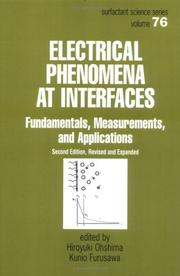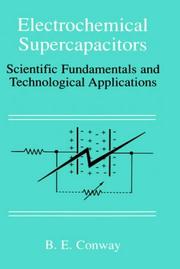| Listing 1 - 4 of 4 |
Sort by
|

ISBN: 0824790391 9780824790394 Year: 1998 Volume: 76 Publisher: New York : Dekker,
Abstract | Keywords | Export | Availability | Bookmark
 Loading...
Loading...Choose an application
- Reference Manager
- EndNote
- RefWorks (Direct export to RefWorks)
Surface chemistry --- Electric double layer --- Chimie des surfaces --- Couche double électrique --- Biopolymère --- Biopolymers --- Phénomène d'interface --- Interface phenomena --- Propriété électrique --- Electrical properties --- Mesure --- Measurement --- Couche double électrique
Book
ISBN: 0201023989 0201023997 9780201023985 9780201023992 Year: 1975 Publisher: Reading (Mass.): Addison-Wesley. Advanced Book Program
Abstract | Keywords | Export | Availability | Bookmark
 Loading...
Loading...Choose an application
- Reference Manager
- EndNote
- RefWorks (Direct export to RefWorks)
fysicochemie --- Electrochemistry --- Electrodes --- Electric double layer --- Couche double électrique --- elektrochemie --- elektroden --- Chemistry, Physical and theoretical --- Double layer, Electric --- Double layer, Electrochemical --- Electrochemical double layer --- Helmholtz double layer --- Electrokinetics --- Electric resistors --- Electrodes. --- Electric double layer. --- Couche double électrique --- Monograph
Book
ISBN: 9781420053692 1420053698 Year: 2010 Publisher: Boca Raton : Taylor & Francis,
Abstract | Keywords | Export | Availability | Bookmark
 Loading...
Loading...Choose an application
- Reference Manager
- EndNote
- RefWorks (Direct export to RefWorks)
Interfaces (Physical sciences) --- Electric double layer --- Surface chemistry. --- Surface energy --- Materials --- Interfaces (Sciences physiques) --- Couche double électrique --- Chimie des surfaces --- Energie de surface --- Matériaux --- Electric properties. --- Propriétés électriques

ISBN: 0306457369 9781475730609 1475730608 1475730586 9780306457364 Year: 1999 Publisher: New York : Plenum Press,
Abstract | Keywords | Export | Availability | Bookmark
 Loading...
Loading...Choose an application
- Reference Manager
- EndNote
- RefWorks (Direct export to RefWorks)
The first model for the distribution of ions near the surface of a metal electrode was devised by Helmholtz in 1874. He envisaged two parallel sheets of charges of opposite sign located one on the metal surface and the other on the solution side, a few nanometers away, exactly as in the case of a parallel plate capacitor. The rigidity of such a model was allowed for by Gouy and Chapman inde pendently, by considering that ions in solution are subject to thermal motion so that their distribution from the metal surface turns out diffuse. Stern recognized that ions in solution do not behave as point charges as in the Gouy-Chapman treatment, and let the center of the ion charges reside at some distance from the metal surface while the distribution was still governed by the Gouy-Chapman view. Finally, in 1947, D. C. Grahame transferred the knowledge of the struc ture of electrolyte solutions into the model of a metal/solution interface, by en visaging different planes of closest approach to the electrode surface depending on whether an ion is solvated or interacts directly with the solid wall. Thus, the Gouy-Chapman-Stern-Grahame model of the so-called electrical double layer was born, a model that is still qualitatively accepted, although theoreti cians have introduced a number of new parameters of which people were not aware 50 years ago.
Storage batteries. --- Electrolytic capacitors. --- Electric double layer. --- Accumulateurs --- Couche double électrique --- Couche double électrique --- Storage batteries --- Electrolytic capacitors --- Electric double layer --- Electrochemistry. --- Physical chemistry. --- Analytical chemistry. --- Electrical engineering. --- Materials science. --- Physical Chemistry. --- Analytical Chemistry. --- Electrical Engineering. --- Characterization and Evaluation of Materials. --- Material science --- Physical sciences --- Electric engineering --- Engineering --- Analysis, Chemical --- Analytic chemistry --- Chemical analysis --- Chemistry, Analytic --- Chemistry --- Chemistry, Theoretical --- Physical chemistry --- Theoretical chemistry --- Chemistry, Physical and theoretical
| Listing 1 - 4 of 4 |
Sort by
|

 Search
Search Feedback
Feedback About
About Help
Help News
News